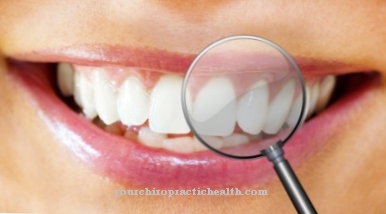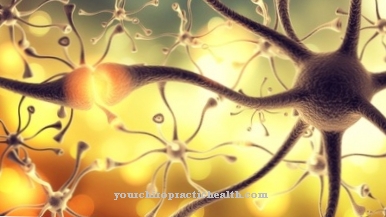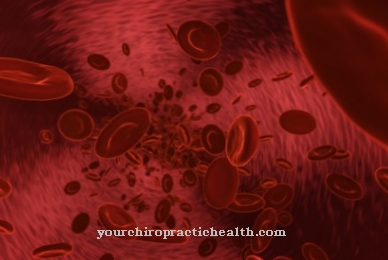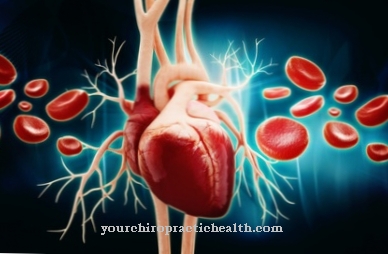Of the Bohr effect indicates the ability of oxygen to bind to hemoglobin depending on the pH value and the carbon dioxide partial pressure. It is largely responsible for gas exchange in organs and tissues. Respiratory diseases and incorrect breathing have an impact on the pH value of the blood via the Bohr effect and disrupt normal gas exchange.
What is the Bohr effect?

The Bohr effect is named after its discoverer Christian Bohr, the father of the famous physicist Niels Bohr. Christian Bohr (1855-1911) recognized the dependence of the oxygen affinity (ability to bind oxygen) of hemoglobin on the pH value or the carbon dioxide or oxygen partial pressure. The higher the pH value, the stronger the hemoglobin's oxygen affinity and vice versa.
Together with the effect of the cooperative binding of oxygen and the influence of the Rapoport-Luebering cycle, the Bohr effect enables hemoglobin to be an ideal oxygen transporter in the organism. These influences change the steric properties of hemoglobin. Depending on the ambient conditions, the ratio between T-hemoglobin, which binds poorly with oxygen, and R-hemoglobin with good oxygen-binding properties is established. Oxygen is normally taken up in the lungs, while oxygen is usually released in the other tissues.
Function & task
The Bohr effect ensures that the body is supplied with oxygen by transporting oxygen with the help of hemoglobin. The oxygen is bound as a ligand to the central iron atom of the hemoglobin. The iron-containing protein complex has four heme units each. Each heme unit can bind an oxygen molecule. Thus each protein complex can contain up to four oxygen molecules.
Changing the steric properties of the heme as a result of the influence of protons (hydrogen ions) or other ligands shifts the equilibrium between the T-form and the R-form of hemoglobin. In oxygen-consuming tissues, the binding of oxygen to hemoglobin is weakened by lowering the pH value. It is better delivered. Therefore, in metabolically active tissues, an increase in the hydrogen ion concentration leads to an increased release of oxygen. The carbon dioxide partial pressure of the blood increases at the same time. The lower the pH value and the higher the carbon dioxide partial pressure, the more oxygen is given off. This goes on until the hemoglobin complex is completely oxygen-free.
In the lungs, the partial pressure of carbon dioxide decreases through exhalation. This leads to an increase in the pH value and thus also to an increase in the oxygen affinity of the hemoglobin. Therefore, in addition to the release of carbon dioxide, oxygen is also taken up by the hemoglobin in the lungs.
Furthermore, the cooperative binding of oxygen depends on the ligands. The central iron atom binds protons, carbon dioxide, chloride ions and oxygen molecules as ligands. The more oxygen ligands there are, the stronger the oxygen affinity at the remaining binding sites. However, all other ligands weaken the affinity of hemoglobin for oxygen. This means that the more protons, carbon dioxide molecules or chloride ions are bound to hemoglobin, the easier it is for the remaining oxygen to be released. A high partial pressure of oxygen, however, favors oxygen binding.
In addition, a different way of glycolysis takes place in the erythrocytes than in the other cells. This is the Rapoport-Luebering cycle. The intermediate 2,3-bisphosphoglycerate (2,3-BPG) is formed during the Rapoport-Luebering cycle. The compound 2,3-BPG is an allosteric effector in the regulation of the oxygen affinity for hemoglobin. It stabilizes T-hemoglobin. This promotes the rapid release of oxygen during glycolysis.
The oxygen bond to hemoglobin is weakened by the decrease in the pH value, the increase in the concentration of 2,3-BPG, the increase in the carbon dioxide partial pressure and the increase in temperature. This increases the release of oxygen. Conversely, increasing the pH value, lowering the 2,3-BPG concentration, lowering the carbon dioxide partial pressure and lowering the temperature of the blood.
Illnesses & ailments
Accelerated breathing in the context of respiratory diseases such as asthma or hyperventilation as a result of panic, stress or habit leads to an increase in the pH value via increased carbon dioxide exhalation due to the Bohr effect. This increases the oxygen affinity of hemoglobin. The release of oxygen in the cells is made more difficult. Therefore, ineffective breathing patterns lead to an insufficient supply of the cells with oxygen (cell hypoxia).
The consequences are chronic inflammation, a weakened immune system, chronic respiratory diseases and many other chronic diseases. According to general medical knowledge, cell hypoxia is often the trigger for diseases such as diabetes, cancer, heart disease or chronic fatigue.
According to the Russian doctor and scientist Buteyko, hyperventilation is not only a result of respiratory diseases, but is also often caused by stress and panic reactions. In the long term, he believes that overbreathing becomes a habit and the starting point for various diseases.
For therapy, consistent nasal breathing, diaphragmatic breathing, extended breathing pauses and relaxation exercises are carried out in order to normalize breathing in the long term. Several studies have shown that the Buteyko Method can reduce the consumption of antispasmodic drugs by 90 percent and of cortisone by 49 percent.
If the exhalation of carbon dioxide is too low during hypoventilation, the body becomes too acidic (acidosis). Acidosis is when the blood pH is below 7.35. The acidosis that occurs during hypoventilation is also known as respiratory acidosis. Causes can be paralysis of the respiratory center, anesthesia or broken ribs. Respiratory acidosis is characterized by shortness of breath, blue lips and increased fluid excretion. The acidosis can lead to cardiovascular disorders with low blood pressure, cardiac arrhythmias and coma.



























